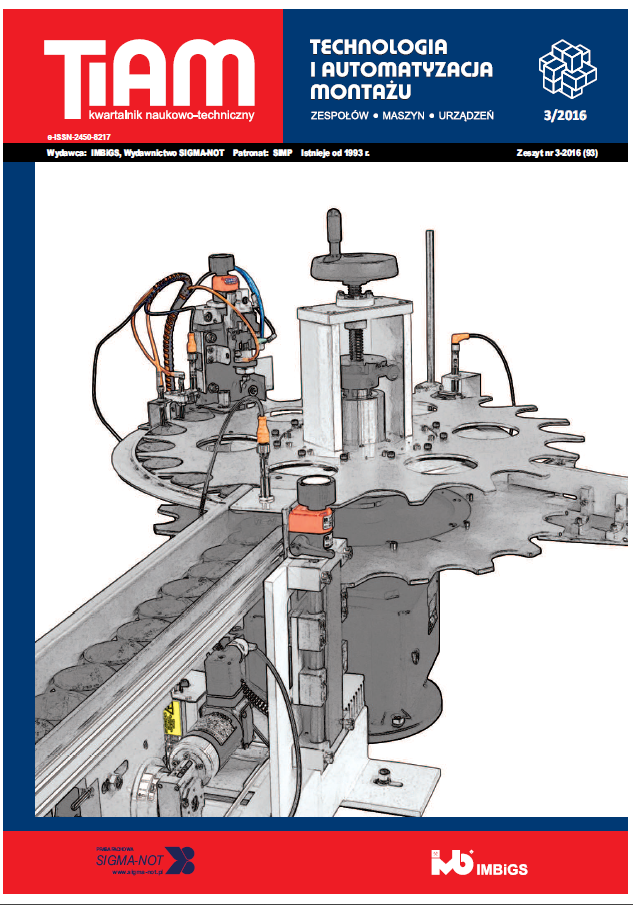Abstract
The paper presents selected results of the surface quality measurements after cutting the samples bonded using different epoxy adhesives. From the point of view of efficiency of assembly processes, it is important that these surfaces do not require additional operations such as deburring or finishing operations. Materials were adhesive disc: 316L steel and Ti6Al4V titanium alloy. The test materials were bonded in conventional lap joint and in a “sandwich” in the different variants. The cutting process was realized with the use of “waterjet” technology under variable speed vf. The article presents the results of research on the value of surface free energy and selected parameters of surface roughness of bonded materials, shows the topography of the surface created by the intersection of the materials to be joined, and the angle of the bevel surface after cutting by jet of water and abrasive. Conclusions from the tests are presented at the final stage of the paper.
This is an Open Access article distributed under the terms of the Creative Commons Attribution License CC BY 4.0 (https://creativecommons.org/licenses/by/4.0/)
References
„Specyfikacje Geometrii Wyrobów (GPS) – wykład dla uczelni technicznych” red. Humienny Z. 2001. Oficyna wydawnicza Politechniki Warszawskiej s. 540.
Blicharski M. 2009. „Inżynieria powierzchni”. Warszawa: WNT.
Ciecińska B., R. Perłowski. 2013. „Swobodna energia powierzchniowa wybranych materiałów lotniczych po obróbce laserowej”. Technologia i Automatyzacja Montażu (1): 56–62.
Jańczuk B., T. Białopiotrowicz. 1987. „Swobodna energia powierzchniowa niektórych polimerów”. Polimery (32): 269–271.
Kłonica M. et. al. 2016. „Polyamide 6 surface layer following ozone treatment”. International Journal of Adhesion and Adhesives (64): 179–187.
Kłonica M. 2015. “Impact of thermal fatigue on young’s modulus of epoxy adhesives”. Advances in Science and Technology Research Journal 9 (29): 103–106.
Kubit A., T. Mączka. 2012. „Zastosowanie techniki wizyjnej w pomiarze odkształcenia bezwzględnego warstwy kleju w spoinie”. Pomiary Automatyka Robotyka (5): 91–97.
Kuczmaszewski J. 2006. “Fundamentals of metal- metal adhesive joint design”. Politechnika Lubelska, Oddział PAN w Lublinie.
Kwiatkowski M. et. al. 2013.“Comparative analysis of energetic properties of Ti6AI4V titanium and ENAW- 2017A (PA6) aluminum alloy surface layers for an adhesive bonding application”. Ozone-Science & Engineering 35 (3): 220–228.
PN-EN ISO 4287:1999/A1:2010P: Specyfikacje geometrii wyrobów. Struktura geometryczna powierzchni: metoda profilowa. Terminy, definicje i parametry struktury geometrycznej powierzchni.
Skoczylas A. 2011. „Analiza porównawcza procesu cięcia wiązką laserową i strumieniem wodno-ciernym”. Advances in Science and Technology (8): 121–128.
Zielecki W. et. al. 2013. “Surface topography effect on strength of lap adhesive joints after mechanical pretreatment”. Archives of Civil and Mechanical Engineering 13 (2): 175–185.
Żenkiewicz M. 2000. „Adhezja i modyfikowanie warstw wierzchniej tworzyw wielkocząsteczkowych”. Warszawa: WNT.

